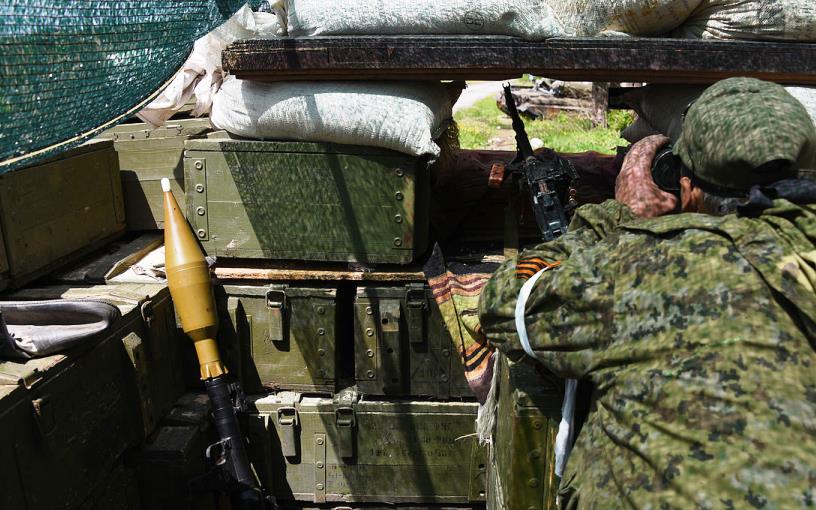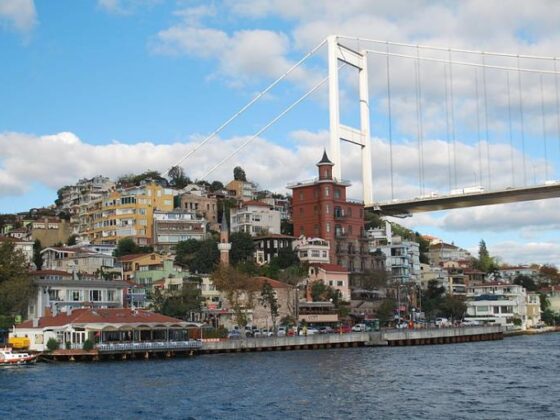(PONARS Eurasia Commentary) What are the different actors’ perspectives on the increased tensions? What does the revival of tensions—and their apparent current decrease—tell us about the state of security?
Georgi Derluguian (NYU Abu Dhabi)
The geopolitical prediction of the Soviet collapse that Randall Collins made back in 1980 could be at work again. In the past, such collapses usually required several blows: three Punic wars before the Roman republic destroyed Carthage, Hapsburg Spain went bankrupt in 1557 unable to suppress Protestantism, the Armada was lost in 1588, and still, it took the Thirty Years War and the Peace of 1648 for Spain to lose its great power status. We can also recall France’s long transition from 1757 to 1815 and Germany’s from 1914 to 1945.
Giovanni Arrighi distinguished the signal and terminal crises in each hegemonic cycle, often a couple of decades apart. He spoke about the United States. But could the theory apply elsewhere? President Vladimir Putin has been countering what he sees as losses from perestroika, and he has had everything at his disposal. Putin comes well-prepared, sober, cynical, and determined not to “lose” another time. He has a high-tech military, a huge and growing domestic police force, diplomats famous for their professionalism and obstinacy, conservatively sound state finances, television and Internet propaganda (modeled on conservative media), and the semi-private resources of entrusted oligarchs.
Could Russia’s strategic positions crack elsewhere? Perhaps via some non-political mass protests over something trivial, or when the activism of educated junior elites face little prospect except emigration, or when the civil bureaucracy begins looking to preserve their careers. The state machinery is now far costlier than it was in Soviet times because officials now expect capitalist levels of consumption. Meanwhile, the controlling and investigative organs seem to routinely use their powers for extortion—after all, they are themselves being extorted by their superiors, accompanied by unpredictable prosecutions of corrupt officials (a dozen former governors are now in jail).
The pressure is mounting because the West finds it far easier to isolate and punish Russia than China, which remains organizationally communist and poses the main existential challenge to the West. Moreover, unlike in Iran or China, the Russian ruling elite is much further removed from their revolutionary purpose and ideological allegiances; they might snap and go for brinkmanship gambles. It is crucially important to exclude the worst outcomes that were so wonderfully and blindly missed back in 1991. In short, I see in Donbas a direct connection to the recent Karabagh war.
Olexiy Haran and Petro Burkovskyi (National University of Kyiv-Mohyla Academy)
Despite all of the pacifist rhetoric and concessions made by President Volodymyr Zelensky since his election in 2019, the Kremlin has continued its military pressure on Ukraine and has been violating the “full ceasefire” that was announced in the summer of 2020. Almost 100 Ukrainian soldiers have been killed. Zelensky recognized that he could not deliver on his key promise of making peace, so he can become a leader who makes Ukraine stronger by containing Russia and his own oligarchs.
Zelensky declared Ukraine’s intention to join NATO. He conducted negotiations with NATO members about acquiring lethal defensive weapons, and he signed a law that allows him to call reservists with combat experience on short notice. Moreover, according to a nationwide DIF poll from this past February, 51 percent of respondents support Zelensky’s policies of resolving the conflict in Donbas, and the number of NATO state supporters grew from 39 percent in November 2020 to 45 percent in February 2021. One can say that in 2014, Ukraine was weak and divided, while now, in 2021, Ukraine is consolidated in facing Russia’s potential attack.
All the while, the Kremlin has doubled its domestic efforts to reconstruct Ukraine as a “grave threat” for Russian security. The Secretary of the Russian Security Council Nikolay Patrushev accused Ukraine of establishing clandestine radical networks and of preparing terrorist attacks against Russian citizens. By moving combat-ready armies to the Ukrainian borders, Russia demonstrated that the “security” of around 400,000 “Russian citizens in Donbas” (a result of Moscow’s “passportization campaign”) could become justification for another invasion. Since Ukraine avoided being trapped by the Minsk agreements with its “special status” for Donbas (designed to stop its further integration with the West), Russia aims to destroy Ukrainian democracy and statehood before it becomes strong enough to repel any kind of non-nuclear attack in cooperation with its international partners.
Sergiy Kudelia (Baylor University)
Over the last year, Ukrainian President Volodymyr Zelensky, pressured by his right-wing opponents, changed the course of the peace settlement in Donbas. He backtracked on some of his key peacemaking initiatives, such as the acceptance of the Steinmeier formula, dismissed the possibility of autonomous status for Donbas, and adopted a more hardline stance with regard to Moscow and its allies in Ukraine. This, predictably, brought the diplomatic process around Donbas to another dead end. However, the relatively successful ceasefire agreement opened the possibility for Zelensky of “freezing” the conflict and making the de facto division of Donbas permanent. This might have been viewed by his administration as a preferred low-risk outcome politically, particularly in light of Zelensky’s dwindling popularity and Ukraine’s economic recession exacerbated by the failure of its COVID-19 vaccination campaign.
The recent buildup of Russian troops along the Ukrainian border, which coincided with renewed hostilities along the contact line in Donbas, indicated that the “freezing” strategy is untenable. The intentional visibility of the Russian troops’ movement was meant to generate uncertainty about Russia’s operational plans and put the Donbas conflict back on the agenda of Ukraine’s Western allies, particularly the new U.S. administration. It also had a clear intimidating effect on Kyiv and triggered Ukraine’s preparation for another ground invasion. These escalatory moves and immediate conciliatory response from the West, which culminated in a Biden-Putin phone call, underscored the strategic value of the conflict for Russia. Moscow can calibrate the intensity of the conflict in accordance with its geopolitical needs without engaging in direct military actions. Its escalatory dominance over the West in Ukraine means that such moves can bring it major foreign policy gains without incurring the costs of direct military confrontation. Russia’s strong incentive to use tensions as a geopolitical lever means that they are likely to recur for as long as conflict persists. This, however, creates ample opportunities for miscalculations on either side that could trigger a full-scale war on the Ukrainian territory.
Despite the rising urgency to settle the conflict, the path to peace has become even harder. Over six hundred thousand people residing in separatist-controlled areas (close to a quarter of the total remaining population) already received Russian citizenship. The Ukrainian language has been further marginalized and excluded from the school curriculum and official use. Separatist leaders have issued new calls for integration with Russia. The new doctrine “Russian Donbas” redefines separatist territories as ethnically Russian entities and positions them as a protector of rights of ethnic Russians and Russian-speaking Ukrainians residing in Ukraine. The incendiary rhetoric about neo-Nazi rulers running Ukraine remains a staple of the separatist discourse and of Russian political talk shows. A recent survey conducted in separatist-controlled areas shows that people there remain apprehensive of Ukraine and largely prefer to see these territories become part of Russia. This, coupled with the sensitivity of Ukrainian leadership to the nationalist mobilization on the streets, makes the prospect of the full implementation of Minsk Agreements highly tenuous. Aside from mutual reluctance to take formal steps prescribed by the agreement, the conflict parties have no shared vision of life after the return of Donetsk and Luhansk to Ukrainian government control—primarily because neither Russia nor the separatist elites are willing to accept Ukraine’s exclusive sovereign presence in these areas. At the same time, Kyiv will never agree to make the exercise of its sovereign powers in Donbas contingent on Moscow’s acquiescence.
Mariya Omelicheva (National War College)
The unprecedented buildup of Russian forces along Ukraine’s eastern border accompanied by military units in the Black Sea, restrictions on the movement of foreign ships through the Kerch straits, and multiple intrusions into NATO members’ airspace gave many U.S. experts and officials the foreboding sense of an imminent invasion of Ukraine. Expressing serious concerns over these developments and calling on Russia to de-escalate its maneuvers, the Biden administration, nevertheless, took a measured approach toward Moscow, being careful not to provoke it militarily. Both State Secretary Antony Blinken and Defense Secretary Lloyd Austin traveled to Brussels to show unwavering support to Ukraine. At the same time, the United States withheld any promise of the accelerated accession of Kyiv to NATO, citing the importance of ongoing reforms in Ukraine. The White House backtracked on its announcement of sending two navy warships to the Black Sea and has been slow in its response to both public and private requests from Kyiv for more weapons to bolster its defenses.
While no one knows Russia’s true motivations, there appears to be an understanding in Washington that Moscow’s posturing may have to do more with the United States than Ukraine. Not only did the escalation of tensions in Donbas and militarization of Russia’s border with Ukraine follow new U.S. sanctions on Russia (for Moscow’s interference in the 2020 presidential election and cyber espionage), but it also closely trailed NATO’s Defender Europe 2021 strategic exercise. These drills, which began in March and are slated to last through June, sent a powerful signal to Moscow that the Alliance is serious about resuming the practice of holding an annual series of exercises united by a single plan, which was interrupted in the 1990s.
In 2018, NATO announced its Readiness Initiative to enhance national militaries’ capabilities to respond to threats from Russia. Its emphasis has been on preparing national army units to face and hold an adversary until NATO response forces arrive. The first Defender Europe 2020 exercise was curtailed due to COVID-19. Defender 2021, while smaller in scope—28,000 military personnel from 27 countries—has more participants, including NATO partners, such as Georgia and Ukraine, which uses the drills to model warfare with Russia. Russia has been watching the ongoing exercises closely and has signaled its preparedness to respond to any perceived threats to its interests.
The opinions expressed are solely those of the authors.











